Shen Creates Tiny Polymer Switch With Big Abilities To Control Heat
Carnegie Mellon University's Sheng Shen, an associate professor of mechanical engineering, and his team have developed a new polymer thermal regulator that can quickly transform from a conductor to an insulator and back again.
When it is a conductor, heat transfers quickly. When it is an insulator, heat transfers much more slowly. By switching between the two states, the thermal regulator can control its own temperature, as well as the temperature of its surroundings, such as a refrigerator or computer.
Polymers are made up of many identical molecules joined together like a chain. Building on past research, the team engineered these molecules to join together in specific ways to control the characteristics of the resulting polymer.

From left, research assistant Wei Gong, master's student Xiao Luo, and Associate Professor Sheng Shen of CMU's Department of Mechanical Engineering.
In order to switch between high to low conductivity, the polymer's structure is altered through heat activation.
The polymer starts with a highly ordered crystalline structure.
"But once you increase the temperature of the polymer fiber, to around 430 Kelvin, then the molecular structure changes from orthorhombic to hexagonal," Shen said. The transformation occurs because the heat targets the molecular bonds. "The bonding of the molecules becomes pretty weak, so the segments can rotate."
Once the segments rotate, the structure becomes disordered, greatly reducing its thermal conductivity. This type of transition is known as a solid-solid transition; although the polymer reaches temperatures close to its melting point, it remains a solid through the process.

When studying the polymer's transformation, Shen concentrated his data on how its conductivity changed. He also gathered data on other phase transitions so he could compare the ratios.
"When you look at all the materials we have on Earth, the thermal conductivity change is, at most, a factor of four upon phase transition." Shen said. "Here, we've already discovered a new material that can have a conductivity change of around 10."
The structural change can happen quickly and occur within a range of 5 Kelvin, and that change is reversible, which allows it to be turned on and off like a switch. The polymer can handle much higher temperatures than other thermal regulators, remaining stable up to 560 Kelvin. It is difficult to break down, so it can survive many transitions. Since the changes are heat-based, there are not as many moving parts as typical cooling methods, making the process much more efficient.
While this research has been explored theoretically in the past, Shen's work is the first time it's been shown experimentally. Shen said he believes that the polymer will have real-world applications.
"This control of heat flow at the nanoscale opens up new possibilities," he said, "such as developing switchable thermal devices, solid-state refrigeration, waste heat scavenging, thermal circuits and computing."
This work builds on previous research in Shen's lab, where his team had developed a polymer nanofiber that was strong, lightweight, thermally conductive, electrically insulating, and bio-compatible — all at less than 100 nanometers wide.
The findings were published in Science Advances in a paper titled "High-Contrast and Reversible Polymer Thermal Regulator by Structural Phase Transition," DOI: 10.1126/sciadv.aax3777. Collaborators included Michael Bockstaller of the Department of Materials Science and Engineering at Carnegie Mellon University, Renkun Chen of the University of California-San Diego, Sukwon Choi of the Pennsylvania State University, Kedar Hippalgaonkar of the Agency for Science Technology and Research (Singapore), and Tengfei Luo of the University of Notre Dame.